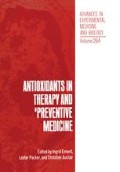Abstract
The iron chelator, deferoxamine (Desferal®), is presently used clinically for the treatment of acute and chronic iron toxicity. The chelator is an effective inhibitor of iron-catalyzed reactions leading to the formation of both oxygen and lipid-derived radicals. Deferoxamine (DFO) has been incorporated in a number of studies involving oxygen and lipid radical mediated reactions leading to tissue injury and has proven efficacious in ameliorating reperfusion injury.
Access this chapter
Tax calculation will be finalised at checkout
Purchases are for personal use only
Preview
Unable to display preview. Download preview PDF.
References
A. Mazur, S. Baez, and E. Shorr, The mechanism of iron release from ferritin as related to its biological properties, J. Biol. Chem. 213:147 (1955).
C. E. Thomas, L. A. Morehouse, and S. D. Aust, Ferritin and superoxide-dependent lipid peroxidation, J. Biol. Chem. 260:3275 (1985).
P. Biemond, A. J. G. Swaak, C. M. Biendorff, and J. F. Koster, Superoxide-dependent and independent mechanisms of iron mobilization from ferritin by xanthine oxidase, Biochem. J. 239:169 (1986).
M. S. Paller, and B. E. Hedlund, Role of iron in postischemic renal injury in the rat,KidneyInt. 34:474 (1980).
G. Ambrosio, J. L. Zweier, W. E. Jacobus, M. L. Weisfeldt, and J. T. Flaherty, Improvement of postischemic myocardial function and metabolism induced by administration of defer oxamine at the time of reflow: The role of iron in the pathogenesis of reperfusion injury, Circulation 76:906 (1987).
S. F. Badylak, A. Simmons, J. Turek, and C. F. Babbs, Protection from reperfusion injury in the isolated rat heart by postischemic deferoxamine and allopurinol administration, Cardiovasc. Res. 21:500 (1987).
R. Bolli, B. S. Patel, W. X. Zhu, P. G. ONeill, M. L. Charlat, and R. Roberts, The iron chelator deferoxamine attenuates postischemic ventricular dysfunction, Am. J., Physiol. 253: H1372-H1380 (1987).
N. E. Farber, G. M. Vercellotti, H. S. Jacob, G. M. Pieper, and G. J. Gross, Evidence for a role of iron in functional and metabolic stunning in the canine heart, Circ. Res. 63:351 (1988).
B. R. Reddy, R. A. Kloner, and K. Przyklenk, Early treatment with deferoxamine limits myocardial ischemia/reperfusion injury, Free Rad. Biol. Med., in press (1989).
C. F. Babbs, The role of iron ions in the genesis of reperfusion injury following successful cardipulmonary resuscitation: Preliminary data and a biochemical hypothesis, Ann. Emerg. Med. 14:777 (1985).
S. Sanan, G. Sharma, R. Malhotra, D. P. Sanan, P. Jain and P. Vadhera: Protection by desferrioxamine against histopathological changes of the liver in the post-oligaemic of clini cal haemomorrhagic shock in dogs: Correlation with improved survival rate and recovery. Free Rad. Res. Commun. 6:29 (1989).
C. F. Whitten, G. W. Gibson, M. H. Good, J. F. Goodwin, and A. J. Brough, Studies in acute iron poisoning. I. Desferrioxamine in the treatment of acute iron poisoning: Clinical observations, experimental studies, and theoretical considerations, Pediatrics 36:322 (1965).
C. F. Whitten, Y-C. Chen, and G. W. Gibson, Studies in acute iron poisoning: II. Further observations on desferrioxamine in the treatment of acute experimental iron poisoning, Pediatrics 38:102 (1966).
A. Slivka, J. Kang, and G. Cohen, Hydroxyl radicals and the toxicity of oral iron, Biochem. Pharmacol. 35:553 (1986).
J. O. Kang, A. Slivka, and G. Cohen, In vivo formation of hydroxyl radicals following intragastric administration of ferrous salts in rats, J. Inorg. Biochem. 35:55 (1989).
J. O. Hoppe, G. M. A. Marcelli, and M. L. Tainter, An experimental study of the toxicity of ferrous gluconate, Am. J. Med. Sri. 230:491 (1955).
P. E. Hallaway, J. W. Eaton, S. S. Panter, and B. E. Hedlund, Modulation of deferoxamine toxicity and clearance by covalent attachment to biocompatible polymers, Submitted for publication (1989).
T.L. Litovitz, B.F. Schmitz, N. Matyunas and T.G. Martin. 1987 Annual Report of the American Association of Poison Control Centers National Data Collection System. Am. J. Emer. Med. 6:479 (1988).
C. E. Ganote, and G. Nahara, Acute ferrous sulfate hepatotoxicity in rats. An electron microscopic and biochemical study, Lab. Invest. 28:426 (1973).
E. Graf, J. R. Mahoney, Jr., J. R. Bryant, and J. W. Eaton, Iron-catalyzed hydroxyl radical formation: Stringent requirement for iron-coordinated water, J. Biol. Chem. 295:3620 (1984).
Author information
Authors and Affiliations
Editor information
Editors and Affiliations
Rights and permissions
Copyright information
© 1990 Plenum Press, New York
About this chapter
Cite this chapter
Hedlund, B.E., Hallaway, P.E., Mahoney, J.R. (1990). High Molecular Weight Forms of Deferoxamine: Novel Therapeutic Agents for Treatment of Iron-Mediated Tissue Injury. In: Emerit, I., Packer, L., Auclair, C. (eds) Antioxidants in Therapy and Preventive Medicine. Advances in Experimental Medicine and Biology, vol 264. Springer, Boston, MA. https://doi.org/10.1007/978-1-4684-5730-8_37
Download citation
DOI: https://doi.org/10.1007/978-1-4684-5730-8_37
Publisher Name: Springer, Boston, MA
Print ISBN: 978-1-4684-5732-2
Online ISBN: 978-1-4684-5730-8
eBook Packages: Springer Book Archive

